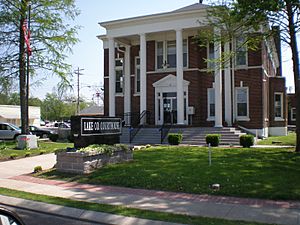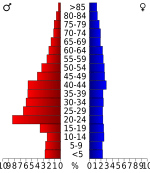Lake County, Tennessee facts for kids
Quick facts for kids
Lake County
|
|
|---|---|

Lake County Courthouse in Tiptonville
|
|

Location within the U.S. state of Tennessee
|
|
 Tennessee's location within the U.S. |
|
| Country | |
| State | |
| Founded | 1870 |
| Named for | Reelfoot Lake |
| Seat | Tiptonville |
| Largest town | Tiptonville |
| Area | |
| • Total | 194 sq mi (500 km2) |
| • Land | 166 sq mi (430 km2) |
| • Water | 28 sq mi (70 km2) 14%% |
| Population
(2020)
|
|
| • Total | 7,005 |
| • Density | 47/sq mi (18/km2) |
| Time zone | UTC−6 (Central) |
| • Summer (DST) | UTC−5 (CDT) |
| Congressional district | 8th |
Lake County is a county in the northwest corner of Tennessee. In 2020, about 7,005 people lived here, making it one of the least populated counties in Tennessee. The main town and county seat is Tiptonville.
Lake County shares a border with Kentucky to the north. The mighty Mississippi River separates it from Missouri to the west. A big part of the northern county is covered by Reelfoot Lake. This lake was formed after huge earthquakes in the early 1800s.
Long ago, there were disagreements over who owned Reelfoot Lake. This led to conflicts between local farmers and big companies. The state government had to step in to help. Today, Reelfoot Lake is part of the Reelfoot Lake State Park. This means it is protected for everyone to enjoy. Also, the Northwest Correctional Complex is in Tiptonville. It's a large state prison that opened in 1981.
Contents
History of Lake County
The story of Lake County is closely linked to Reelfoot Lake. This natural lake was created by the powerful New Madrid earthquakes in 1811 and 1812. The area around the lake has many wetlands. At first, this land was part of Obion County.
Lake County was officially formed in 1870, after the Civil War. People living near the lake found it hard to travel through the swampy areas to reach the old county seat, which was Troy, Tennessee. So, when Lake County was created, Tiptonville became the new main town.
The Reelfoot Lake Conflict
In 1907, a big disagreement happened in Lake and Obion counties. A private company, the West Tennessee Land Company, tried to take control of Reelfoot Lake. They wanted to drain the lake. Local people, who relied on the lake for fishing and hunting, were very upset. A group called the "Night Riders of Reelfoot Lake" protested against the company.
The situation became very serious. The Governor of Tennessee, Malcolm Patterson, personally brought the Tennessee National Guard to the area. They arrested many people thought to be Night Riders to bring peace back to the region.
Protecting Reelfoot Lake
To stop private companies from controlling the lake, the state of Tennessee took ownership of Reelfoot Lake in 1914. Later, in 1925, Governor Austin Peay made the lake a special area for hunting and fishing. This was an important step. It helped lead to the creation of the larger Reelfoot Lake State Park, which protects the lake for everyone today.
Geography
Lake County covers about 194 square miles. About 166 square miles of this is land, and 28 square miles (or 14%) is water. It is one of the smallest counties in Tennessee.
Neighboring Counties
- Fulton County, Kentucky (north)
- Obion County (east)
- Dyer County (south)
- Pemiscot County, Missouri (west)
- New Madrid County, Missouri (northwest)
Protected Natural Areas
Lake County is home to parts of several important natural areas:
- Lake Isom National Wildlife Refuge
- Reelfoot National Wildlife Refuge (part)
- Reelfoot Lake State Natural Area (part)
- Reelfoot Lake State Park (part)
- Tumbleweed Wildlife Management Area (part)
Population Changes
From the 1950s to the 1990s, the number of people living in Lake County went down. Many African Americans moved to bigger cities or to the West Coast during a time called the Great Migration.
| Historical population | |||
|---|---|---|---|
| Census | Pop. | %± | |
| 1870 | 2,428 | — | |
| 1880 | 3,968 | 63.4% | |
| 1890 | 5,304 | 33.7% | |
| 1900 | 7,368 | 38.9% | |
| 1910 | 8,704 | 18.1% | |
| 1920 | 9,075 | 4.3% | |
| 1930 | 10,486 | 15.5% | |
| 1940 | 11,235 | 7.1% | |
| 1950 | 11,655 | 3.7% | |
| 1960 | 9,572 | −17.9% | |
| 1970 | 7,896 | −17.5% | |
| 1980 | 7,455 | −5.6% | |
| 1990 | 7,129 | −4.4% | |
| 2000 | 7,954 | 11.6% | |
| 2010 | 7,832 | −1.5% | |
| 2020 | 7,005 | −10.6% | |
| U.S. Decennial Census 1790–1960 1900–1990 1990–2000 2010–2020 2020 |
|||
As of the 2020 United States census, there were 7,005 people living in Lake County. Most residents were White (about 67.88%), followed by Black or African American (about 26.15%).
Media
Radio stations
- WTNV FM 97.3
- KMIS-AM 1050
Newspaper
- The Lake County Banner
Education
- Lake County High School (grades 9–12)
- Lara Kendall Elementary School (grades K–8)
- Margaret Newton Elementary School (grades K–6)
Communities
Towns
- Ridgely
- Tiptonville (county seat)
Small Communities
- Phillippy
- Wynnburg
Reelfoot Lake State Park
The eastern part of Lake County is mostly within Reelfoot Lake State Park. This park is a fun place for many activities like boating, hunting, fishing, and watching birds. A special event each year is seeing Bald Eagles build their nests in the park.
Images for kids
See also
 In Spanish: Condado de Lake (Tennessee) para niños
In Spanish: Condado de Lake (Tennessee) para niños



